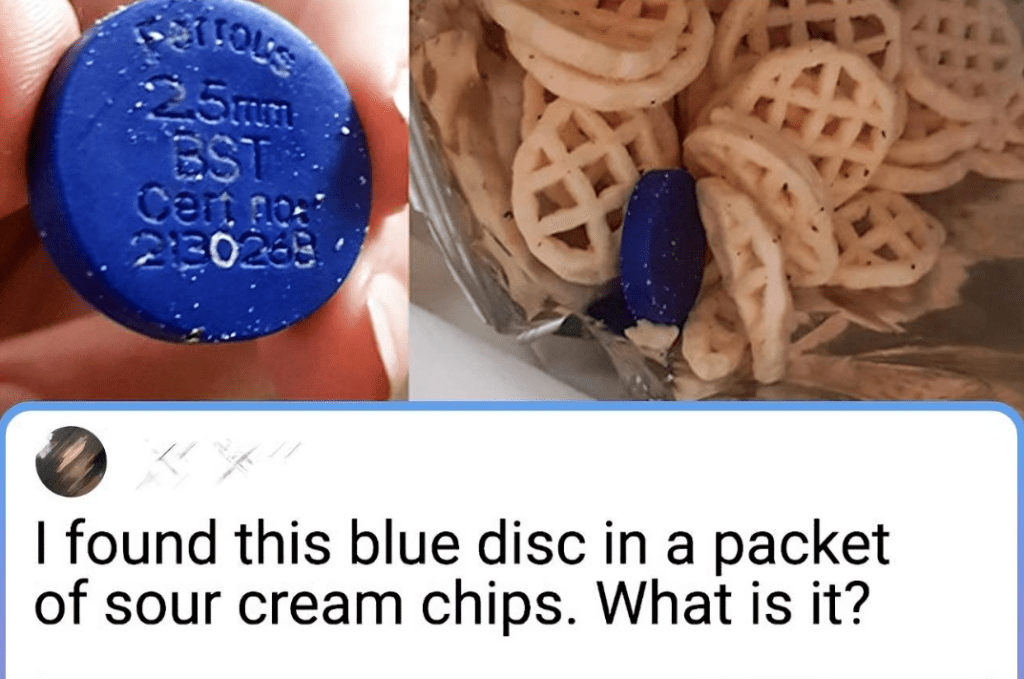Have you ever opened a bag of chips, expecting only crispy, flavorful bites, but instead, you found a mysterious blue disc hidden among them? If so, you’re not alone. Many people have stumbled upon this puzzling object, often embossed with text such as “Ferrous 25mm BST, Cert No. 213026B.” But what does it mean? And more importantly, how did it end up in your snack?
What Is the Blue Disc Found in a Packet of Chips?

At first glance, you might think it’s a promotional token, a production defect, or even an unexpected prize. However, this small blue disc is actually a metal detector test chip used in food processing plants.
This test chip is designed to ensure that food safety equipment—specifically, metal detectors—are working correctly. These chips are strategically placed on the production line to verify whether the detectors can identify and remove potential foreign objects. The blue color helps it stand out from the food, making it easier to spot if something goes wrong.
Why Are Metal Detector Test Chips Used in Food Manufacturing?
Food safety is a top priority for manufacturers. The presence of any foreign object, whether metal, plastic, or glass, poses a significant risk to consumers. To prevent contamination, most factories use metal detectors to scan food items before they are packaged and shipped.
Here’s how the process works:
- Test chips—like the one you found—are deliberately inserted into the production line at set intervals.
- Metal detectors scan the products, ensuring they catch the test chips.
- If the machine detects the chip, it triggers an alert and removes the contaminated item.
- If the chip is NOT detected, it signals a potential failure in the system, and production is halted until the issue is resolved.
Why Did the Test Chip End Up in My Chips?
Now, here’s where things get concerning. The very reason test chips exist is to prevent foreign objects from getting through. So if you found one in your bag of chips, it means something seriously went wrong in the quality control process.
There are a few possible explanations:
- The chip was misplaced and never retrieved – This suggests a human error where someone forgot to remove the test chip after conducting quality control.
- The metal detector failed – This is the most alarming possibility. If the detector failed to catch the test chip, it may have also missed other harmful objects, such as metal fragments or contaminants.
- Production oversight – Sometimes, manufacturing processes get rushed, and crucial safety checks are overlooked.
Regardless of the reason, this is a major red flag that warrants immediate action.
What Should You Do If You Find a Metal Detector Test Chip in Your Food?
If you ever find a test chip inside a food product, take the following steps:
- Do NOT consume any more of the product – There could be other contaminants present that went undetected.
- Keep the packaging and the chip – This will be crucial when reporting the issue.
- Contact the manufacturer immediately – Most brands have customer service lines or emails where you can report quality concerns.
- Request an explanation and possible recall information – If a test chip made it into your food, there’s a chance others might have had the same experience.
- Consider reporting the issue to a food safety authority – Agencies like the FDA (in the U.S.) or the FSA (in the UK) monitor food safety standards and may investigate further.
Will the Manufacturer Face Consequences?
Yes! Food safety protocols require companies to document every test chip used in their quality control process. When a test chip goes missing, production should stop immediately until it is found.
If you report the incident, the company will likely conduct an internal investigation to determine how this breach occurred. In some cases, it may even lead to:

- Product recalls – If multiple reports emerge, the company may be forced to recall entire batches of the affected product.
- Fines and penalties – Regulatory agencies may impose fines if they determine that safety protocols were neglected.
- Operational reviews – Manufacturers might overhaul their processes to prevent similar failures in the future.
Could There Be Other Foreign Objects in My Chips?
The unfortunate reality is that if a test chip made it through, other foreign objects could have as well. While food safety measures exist to minimize risks, errors do happen. There have been cases of consumers finding:
- Plastic or rubber fragments from conveyor belts
- Metal shavings from broken machinery
- Glass pieces from shattered equipment
- Insects or other biological contaminants
This is why quality control is so critical. The presence of a metal detector test chip in your chips raises serious questions about the reliability of the manufacturer’s safety measures.
Final Thoughts: Should You Be Concerned?
Absolutely. While finding a blue test chip in your chips might seem like a bizarre fluke, it’s actually a major food safety failure. These chips are meant to stay on the production line, not end up in your snack bag.
If this happens to you, take action. Report it, demand accountability, and spread awareness. Food safety should never be compromised, and manufacturers must be held to the highest standards to ensure that what we eat is truly safe.
Mulher ajuda pai solteiro em loja e vê pulseira que ela enterrou com o filho na filha dele

A ida comum de Linette ao supermercado tomou um rumo assustador quando ela viu uma pulseira de prata na criança de um estranho — a mesma pulseira que ela havia enterrado com sua filha cinco anos atrás. Determinada a descobrir a verdade, ela mergulhou em um passado obscuro, descobrindo segredos que mudariam sua vida para sempre.
Começou como qualquer outra manhã de terça-feira. Eu estava com pressa, atrasado como sempre, e a última coisa que eu queria era lidar com a multidão no mercado. Mas eu estava sem leite, e não podia mais ignorar a geladeira vazia. As tarefas maçantes e repetitivas da vida cotidiana muitas vezes pareciam um lembrete cruel de como as coisas eram diferentes agora. Ainda assim, a vida tinha que continuar.

Retrato de Linette | Fonte: Meio da Jornada
Enquanto eu empurrava meu carrinho pelos corredores, verificando mentalmente os itens da minha lista, avistei um homem lutando com uma criança na seção de cereais. Sua filha, provavelmente com cerca de três anos, estava tendo um colapso total, completo com lágrimas, gritos e braços agitados.
O homem parecia completamente derrotado, seus ombros caídos sob o peso do que parecia ser muito mais do que apenas uma manhã difícil. Senti uma pontada de simpatia; eu já tinha estado lá antes — anos atrás.

Homem de meia idade devastado | Fonte: Midjourney
Eu me aproximei, meus instintos maternais entrando em ação. “Precisa de uma mão?”, perguntei, oferecendo a ele um sorriso que eu esperava que fosse reconfortante. O homem olhou para cima, sua expressão era uma mistura de surpresa e alívio. Era como se ele estivesse se afogando, e eu tivesse acabado de lhe jogar uma tábua de salvação.
“Obrigado”, ele disse, passando a mão pelo cabelo desgrenhado. Sua voz estava cheia de exaustão. “Somos só nós dois, e manhãs como essa podem ser difíceis. Especialmente depois que a mãe dela nos deixou há um ano.”

Bob falando com Linette | Fonte: Midjourney
Havia uma honestidade crua em sua voz que me pegou desprevenido. Não era apenas o cansaço habitual dos pais — este homem estava lutando contra o peso da tristeza. Agachei-me ao nível da menina, esperando acalmá-la.
Ela olhou para mim com os olhos cheios de lágrimas, seu pequeno rosto corado pelo esforço de sua birra. Eu gentilmente entreguei a ela uma caixa de cereal, um que era seu favorito, a julgar pela forma como ela parou de chorar instantaneamente. Seus pequenos dedos agarraram a caixa como se fosse uma tábua de salvação, e seus soluços diminuíram para fungadas silenciosas.

Uma menina triste com uma caixa de cereal | Fonte: Midjourney
“Assim está melhor”, eu disse suavemente, tentando encontrar os olhos dela com uma expressão gentil. Foi então que notei a pulseira em seu pulso — uma delicada corrente de prata personalizada com uma pequena cruz pendurada nela. Meu coração parou.
Eu conhecia aquela pulseira. Eu a tinha enterrado com minha filha.

Uma pequena pulseira | Fonte: Midjourney
Uma onda de tontura tomou conta de mim, e o mercado pareceu ficar borrado nas bordas. Minha mente correu enquanto eu tentava compreender o que estava vendo. Como a filha desse homem poderia ter algo que pertencia à minha garotinha?
Minha filha, minha doce Emily, que morreu há cinco anos após uma batalha contra a leucemia. Eu coloquei aquela pulseira em sua mão quando nos despedimos. E, no entanto, aqui estava ela, balançando no pulso da filha deste estranho como se nada tivesse acontecido.

Linette chocada | Fonte: Meio da Jornada
O homem percebeu meu olhar e me lançou um olhar curioso. “Você está bem?”, ele perguntou, preocupação aparecendo em sua voz.
Rapidamente disfarcei meu choque com um sorriso forçado. “Sim, só um pouco tonta. Vou ficar bem.”
Ele assentiu, ainda parecendo preocupado, mas, felizmente, não insistiu mais. Depois de mais alguns minutos de conversa, desejei-lhes tudo de bom e corri para terminar minhas compras. Mas minha mente estava girando. Eu não conseguia deixar para lá. Eu tinha que descobrir como aquela pulseira foi parar no pulso dela.

Linette continua comprando | Fonte: Midjourney
Pelos próximos dias, não consegui parar de pensar nisso. A pulseira era mais do que apenas uma joia; era um símbolo do meu amor por Emily, algo que eu achava que estava enterrado com ela para sempre. Até voltei à loja na mesma hora, esperando encontrá-las novamente, mas elas não estavam em lugar nenhum.
Depois de dias de noites sem dormir e preocupações sem fim, decidi abordar a situação de forma diferente. A visão daquela pulseira me assombrava, então fiz algumas pesquisas no passado. Não foi fácil, mas eu precisava de respostas. O que descobri me deixou de coração partido e furioso.

Linette sem dormir | Fonte: Midjourney
Anos atrás, a funerária que havia cuidado dos arranjos de Emily se envolveu em um escândalo. O diretor, um homem chamado Harold Simmons, foi demitido por maus tratos. Ele estava vendendo itens pessoais da falecida, incluindo lembranças destinadas a ficar com os entes queridos em seus túmulos. A pulseira da minha filha — a pulseira de Emily — foi roubada e vendida, provavelmente sem pensar duas vezes.
Eu não podia deixar a raiva me consumir, embora fosse tentador. Em vez disso, decidi entrar em contato com o homem cuja filha agora usava a pulseira de Emily. Confronto não era a resposta. Não era culpa dele, e eu sabia disso.

Linette Irritada | Fonte: Midjourney
Compartilhei a situação com minha amiga próxima, e ela conhecia o homem que concordou em me dar suas informações de contato. Foi estranho escrever a carta, mas coloquei meu coração nela. Expliquei o significado da pulseira, a dor de perder Emily e como vê-la no pulso de sua filha havia despertado emoções que pensei ter enterrado há muito tempo.
Poucos dias depois, meu telefone tocou. Era um número desconhecido, mas tive a sensação de que era ele. Atendi, meu coração batendo forte.

A esperançosa Linette em seu telefone | Fonte: Midjourney
“Olá, aqui é Linette?” perguntou a voz. Era calorosa e preocupada.
“Sim, é ela. Este é o Sr. Daniels?” Eu respondi, tentando firmar minha voz.
“Por favor, me chame de Bob”, ele disse. Houve uma pausa, e então ele continuou, “Eu li sua carta. Sinto muito, Linette. Eu não tinha ideia sobre a história da pulseira. Quando a comprei, pensei que era apenas uma bela joia para minha filha. Não consigo imaginar o quão doloroso isso deve ser para você.”

Bob falando ao telefone | Fonte: Midjourney
“Eu aprecio isso, Bob”, eu disse, minha voz suavizando. “Eu sei que isso não é culpa sua. Eu só… eu só quero consertar as coisas.”
Ele suspirou, o peso da situação evidente em seu tom. “Escute, eu gostaria de ajudar você, se você me deixar. Sou advogado e acho que podemos ter um caso contra a funerária. Isso é mais do que apenas a pulseira. É sobre o princípio, a confiança que eles violaram.”
Fiquei surpreso com sua oferta. “Você faria isso por mim?”

Linette ouvindo Bob | Fonte: Midjourney
“Absolutamente”, ele disse, com uma sinceridade que me surpreendeu. “Ninguém deveria passar pelo que você passou. Vamos garantir que ninguém mais tenha que passar.”
Nos meses seguintes, Bob e eu trabalhamos juntos no caso. Ele era implacável em sua busca por justiça, e sua gentileza era um bálsamo para meu coração ferido. Passávamos longas horas em seu escritório, examinando documentos, reunindo evidências e nos preparando para o tribunal. Sua filha, Emma, frequentemente se juntava a nós, colorindo silenciosamente ou brincando com seus brinquedos em um canto. Comecei a sentir uma conexão com ela também. Ela era doce e gentil, assim como Emily tinha sido.

Bob discutindo o caso com Linette | Fonte: Midjourney
Uma noite, depois de um dia particularmente exaustivo de trabalho, Bob olhou para mim por cima da borda de sua xícara de café. “Sabe, Linette, esse caso — não é mais só sobre a pulseira, é?”
Balancei a cabeça, sentindo um nó na garganta. “Não, não é. É sobre encerramento. Para Emily, para mim… e talvez até para você e Emma.”
Ele assentiu, com um olhar pensativo nos olhos. “Acho que você está certo. E estou feliz que estamos fazendo isso juntos.”

Linette triste | Fonte: Meio da Jornada
Finalmente, chegou o dia do julgamento. Entramos no tribunal de cabeça erguida, determinados a fazer com que nossas vozes fossem ouvidas. Bob apresentou nosso caso com paixão e precisão, destacando a dor emocional e a traição que as ações da funerária causaram.
Quando o veredito saiu, senti um peso sendo tirado dos meus ombros. Nós vencemos. A funerária foi condenada a pagar um acordo substancial, e eles emitiram um pedido público de desculpas. Mas, mais importante, senti uma sensação de encerramento. A justiça havia sido feita.

Martelo de madeira marrom | Fonte: Pexels
Depois do julgamento, enquanto estávamos do lado de fora do tribunal, Bob se virou para mim com um sorriso caloroso. “Conseguimos, Linette. Conseguimos justiça para Emily.”
Lágrimas brotaram em meus olhos enquanto eu concordava. “Obrigado, Bob. Por tudo.”
Continuamos a nos ver e, com o passar do tempo, nosso relacionamento se aprofundou. Começamos a namorar e me envolvi mais na vida de Emma. A garotinha que antes usava a pulseira que me causou tanta dor agora parecia parte da minha família.

Uma nova família | Fonte: Midjourney
No final, percebi que, às vezes, os piores momentos de nossas vidas podem levar às bênçãos mais inesperadas. A pulseira, antes um lembrete de tristeza, havia se tornado um símbolo de esperança e um novo capítulo em minha vida.
Um simples ato de gentileza para com sua vizinha muda de seis anos levou Stephanie, de 45 anos, a um turbilhão de descobertas inesperadas. O que começou como uma doce troca de bugigangas logo revelou um segredo assustador que fez Stephanie questionar tudo o que ela achava que sabia sobre a família vizinha.
Este trabalho é inspirado em eventos e pessoas reais, mas foi ficcionalizado para fins criativos. Nomes, personagens e detalhes foram alterados para proteger a privacidade e melhorar a narrativa. Qualquer semelhança com pessoas reais, vivas ou mortas, ou eventos reais é mera coincidência e não intencional do autor.
O autor e a editora não fazem nenhuma reivindicação quanto à precisão dos eventos ou à representação dos personagens e não são responsáveis por nenhuma interpretação errônea. Esta história é fornecida “como está”, e quaisquer opiniões expressas são as dos personagens e não refletem as opiniões do autor ou da editora.



Leave a Reply